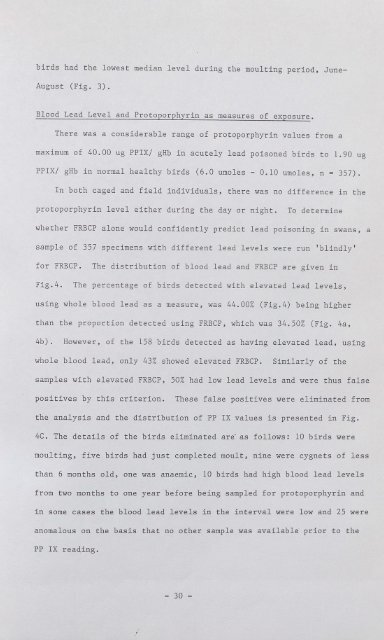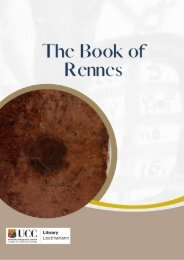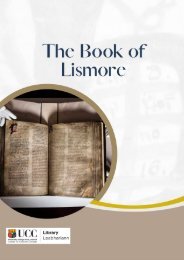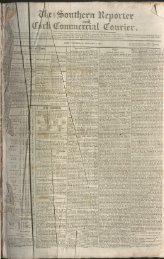Lead Toxicity in Mute Swans
LEAD TOXICITY IN MUTE SWANS Cygnus olor (Gmelin). By JOHN O'HALLORAN A thesis submitted to the National University of Ireland in candidature for the degree of Doctor of Philosophy September 1987
LEAD TOXICITY IN MUTE SWANS
Cygnus olor (Gmelin).
By
JOHN O'HALLORAN
A thesis submitted to the National University of Ireland
in candidature for the degree of Doctor of Philosophy
September 1987
Create successful ePaper yourself
Turn your PDF publications into a flip-book with our unique Google optimized e-Paper software.
irds had the lowest median level dur<strong>in</strong>g the moult<strong>in</strong>g period, June<br />
August (Fig. 3).<br />
Blood <strong>Lead</strong> Level and Protoporphyr<strong>in</strong> as measures of exposure.<br />
There was a considerable range of protoporphyr<strong>in</strong> values from a<br />
maximum of 40.00 ug PPIX/ gHb <strong>in</strong> acutely lead poisoned birds to 1.90 ug<br />
PPIX/ gHb <strong>in</strong> normal healthy birds (6.0 umoles - 0.10 umoles, n = 357).<br />
In both caged and field <strong>in</strong>dividuals, there was no difference <strong>in</strong> the<br />
protoporphyr<strong>in</strong> level either dur<strong>in</strong>g the day or night.<br />
To determ<strong>in</strong>e<br />
whether FRBCP alone would confidently predict lead poison<strong>in</strong>g <strong>in</strong> swans, a<br />
sample of 357 specimens with different lead levels were run 'bl<strong>in</strong>dly'<br />
for FRBCP.<br />
The distribution of blood lead and FRBCP are given <strong>in</strong><br />
Fig.4.<br />
The percentage of birds detected with elevated lead levels,<br />
us<strong>in</strong>g whole blood lead as a measure, was 44.00% (Fig.4) be<strong>in</strong>g higher<br />
than the proportion detected us<strong>in</strong>g FRBCP, which was 34.50% (Fig. 4a,<br />
4b).<br />
However, of the 158 birds detected as hav<strong>in</strong>g elevated lead, us<strong>in</strong>g<br />
whole blood lead, only 43% showed elevated FRBCP.<br />
Similarly of the<br />
samples with elevated FRBCP, 50% had low lead levels and were thus false<br />
positives by this criterion. These false positives were elim<strong>in</strong>ated from<br />
the analysis and the distribution of PP IX values is presented <strong>in</strong> Fig.<br />
4C. The details of the birds elim<strong>in</strong>ated are' as follows: 10 birds were<br />
moult<strong>in</strong>g, five birds had just completed moult, n<strong>in</strong>e were cygnets of less<br />
than 6 months old, one was anaemic, 10 birds had high blood lead levels<br />
from two months to one year before be<strong>in</strong>g sampled for protoporphyr<strong>in</strong> and<br />
<strong>in</strong> some cases the blood lead levels <strong>in</strong> the <strong>in</strong>terval were low and 25 were<br />
anomalous on the basis that no other sample was available· prior to the<br />
PP IX read<strong>in</strong>g.<br />
- 30 -
















